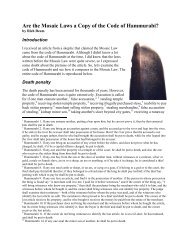Coming to Grips with the Early Church Fathers - Evidence for God ...
Coming to Grips with the Early Church Fathers - Evidence for God ...
Coming to Grips with the Early Church Fathers - Evidence for God ...
You also want an ePaper? Increase the reach of your titles
YUMPU automatically turns print PDFs into web optimized ePapers that Google loves.
<strong>Coming</strong> <strong>to</strong> <strong>Grips</strong> <strong>with</strong> <strong>the</strong> <strong>Early</strong> <strong>Church</strong> Fa<strong>the</strong>rs’ Perspective on Genesis John Millam<br />
of hours. For <strong>the</strong>se are <strong>the</strong> twenty-four witnesses of <strong>the</strong> days and nights which sit be<strong>for</strong>e<br />
<strong>the</strong> throne of <strong>God</strong>…<br />
We see that Vic<strong>to</strong>rinus’ emphasis on a day as 24-hours is just a numerological parallel <strong>to</strong> <strong>the</strong> 24<br />
elders (or angels) that surround <strong>the</strong> throne of <strong>God</strong> (Revelation 4:4). Subdividing a day in<strong>to</strong><br />
exactly two 12-hour periods is likewise driven by numerical symbolism because <strong>the</strong> actual length<br />
of daytime varies considerably <strong>with</strong> location and season. In no case is Vic<strong>to</strong>rinus specifically<br />
trying <strong>to</strong> address <strong>the</strong> nature of <strong>the</strong> Genesis days.<br />
Mook’s use of Vic<strong>to</strong>rinus <strong>to</strong> support a calendar-day view shows deficient scholarship and<br />
selective quoting. Clearly, Vic<strong>to</strong>rinus is far from being a literalist (according <strong>to</strong> how we use that<br />
term <strong>to</strong>day). So he actually does more <strong>to</strong> undercut Mook’s 24-hour day interpretation than he<br />
does <strong>to</strong> support it.<br />
Hippolytus’ Chronological Symbolism<br />
Mook lists Hippolytus of Rome (third century) as defending <strong>the</strong> idea that human his<strong>to</strong>ry would<br />
last exactly 6,000 years. Here, I’ll focus on a related point where Hippolytus teaches that Jesus<br />
was born in <strong>the</strong> year 5500 from creation (Commentary on Daniel, Fragment 2.4–6). However,<br />
Hippolytus did not derive this value from adding up <strong>the</strong> ages in Scripture (although he may have<br />
borrowed that estimate from o<strong>the</strong>rs who did). Instead, his argument rests on an allegorical<br />
interpretation of three different Bible verses.<br />
First, he interprets Revelation 17:10 (“Five [kings] have fallen, one is, <strong>the</strong> o<strong>the</strong>r has not yet<br />
come”) as referring allegorically <strong>to</strong> millennia, hence suggesting that Christ lived between <strong>the</strong><br />
fifth and sixth millennia. Second, he views <strong>the</strong> sum of <strong>the</strong> Ark of <strong>the</strong> Covenant’s dimensions (5<br />
1/2 cubits in Exodus 25:10) as marking 5 1/2 millennia <strong>to</strong> Christ. (The Ark was commonly seen<br />
as a Chris<strong>to</strong>logical symbol.) Third, he interprets <strong>the</strong> words “now is <strong>the</strong> sixth hour” (John 19:14),<br />
as corresponding <strong>to</strong> a half day or 500 years (i. e., half of a millennial “day”). In all three cases,<br />
Hippolytus’ arguments are highly nonliteral.<br />
“Literal” Hebrew<br />
There is an even broader and more significant problem that applies <strong>to</strong> all of <strong>the</strong> church fa<strong>the</strong>rs—<br />
<strong>the</strong>y did not know Hebrew. This is critical because ancient Hebrew is very different from Greek<br />
and Latin. The church fa<strong>the</strong>rs were dependent upon Greek and Latin translations, which affected<br />
how <strong>the</strong>y interpreted Genesis. So, it is ra<strong>the</strong>r misleading <strong>to</strong> refer <strong>to</strong> Basil and company as<br />
literalists when <strong>the</strong>ir interpretation was not, in fact, based on <strong>the</strong> actual Hebrew. This same<br />
problem exists <strong>to</strong>day where commenta<strong>to</strong>rs rely heavily on English translations.<br />
Allegorists/Literalists Conclusions<br />
Mook draws a sharp line between <strong>the</strong> allegorists and literalists among <strong>the</strong> church fa<strong>the</strong>rs. In<br />
reality, this distinction is blurry. When it came <strong>to</strong> <strong>the</strong> Old Testament, all <strong>the</strong> early church fa<strong>the</strong>rs<br />
used an assortment of nonliteral modes of interpretation <strong>to</strong> varying degrees. 29 In <strong>the</strong> end, even<br />
<strong>the</strong> so-called literalists weren’t always literal and were not following ancient Hebrew. As a<br />
29. Bradshaw, Creationism and <strong>the</strong> <strong>Early</strong> <strong>Church</strong>, chapter 1.<br />
Page 10 <strong>Evidence</strong> <strong>for</strong> <strong>God</strong> from Science






